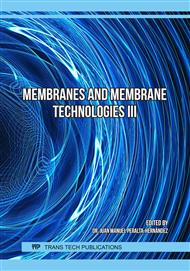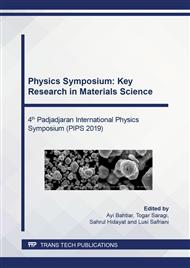p.282
p.288
p.297
p.303
p.310
p.315
p.320
p.329
p.338
Morphology of Micro-Porous Membrane of Waste Cigarette Butts Using Phase Inversion Method
Abstract:
The separation technique in industrial processes with membrane technology is very important. Ultrafiltration membrane is one type of membrane using the principle of pressure-push force. One of the most commonly used ultrafiltration membrane materials is cellulose acetate (CA) membrane. The advantage of CA as a membrane material is that easily produced and its raw material which is a renewable source. The aim of this work is to present a simple experimental and simulation studies to illustrate the phase separation in the membrane synthesis process by the phase inversion technique. Simulation is used to determine the surface characteristics of the synthesized membrane. Two systems commonly used for the preparation of membrane synthesis are waste cigarette butts (WCB)/acetone/water. The effect of adding WCB concentrations (1 and 2 pieces) to the initial polymer casting solution was studied through simulation and compared with available experimental data. The experimental results are in accordance with the simulation was carried out. It shows that the surface profile of the membrane with the composition of the polymer film during precipitation can provide important information about the structure and substructure of the membrane formed. This also shows that the influence of CA concentration is closely related to changes in pore size on the membranes that are formed. The asymmetrical membrane structure prepared by the phase inversion process is influenced by the type and concentration of the polymer (WCB), solvent, membrane thickness and temperature and processing time.
Info:
Periodical:
Pages:
310-314
Citation:
Online since:
August 2020
Keywords:
Price:
Сopyright:
© 2020 Trans Tech Publications Ltd. All Rights Reserved
Share:
Citation:



